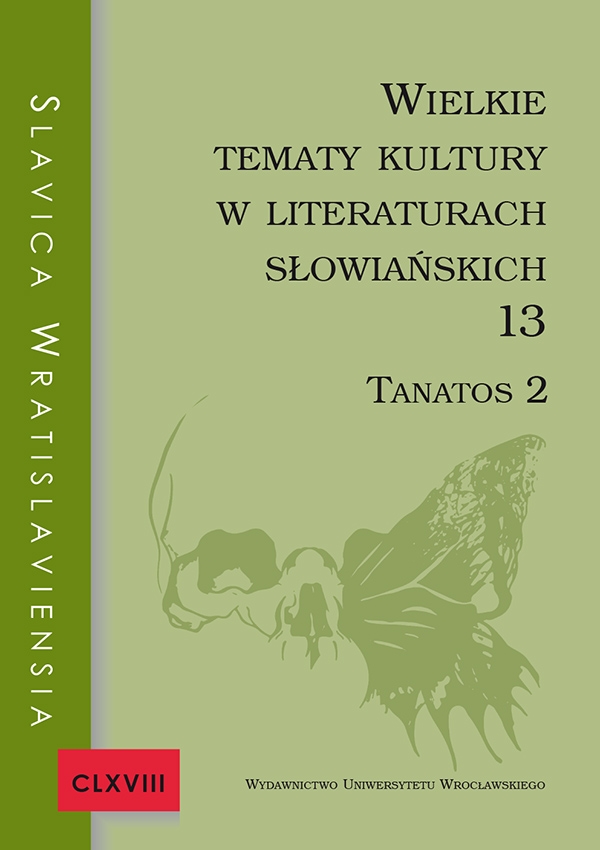

Literatury Słowiańszczyzny zachodniej

Motif of death in the work of Slovak, Czech and Hungarian authors of Catholic literature
In the context of the evolution of religious literature, including the poetics of Slovak, Czech and Hungarian Catholic literature, the motif of death is not particularly unusual. This fact is clearly noticeable in the work of authors of the turn of the 19th century and the entire 20th century, as well as in the following millennium. For example, in the first phase of the creative work of Jakub Deml, who is considered one of the most important representatives of Czech Catholic literature of the first half of the 20th century, mirroring the so-called apocalyptic realism, we notice the thematization of solitude, death, extinction and nothingness. Death in Deml’s work is depicted as an entity that one seeks with an affection and desire, while “it constantly encounters Life. But as soon as they get excited and look for Life, they constantly meet Death, even those who don’t look for one for themselves”. Few years afterwards, a very similar thesis was developed by the later Catholic convert, important thinker and — it can be said — a comrade of the author of Slovak Catholic modernism, Pavol Strauss: “Life consists of search for life and it finds death within”. A Hungarian writer János Pilinszky, who besides spiritual-Christian poetry wrote great essays, the so-called Lyrical Diaries, wrote regarding death: “Death doesn’t exist for real, at least not the one that can be seen from the outside. We have to live first to be able to consider death”. And finally, Jan Zahradníček in his debut collection shifts the perception of death to the next semantic level, when it his poem Their shadow he writes “for the living ones I was alive too much / and for the alive ones I was too dead”. The aim of this paper is to interpret the motif of death in the work of selected authors of the Slovak, Czech and Hungarian Catholic literature.
Motyw śmierci w twórczości słowackich, czeskich i węgierskich autorów literatury katolickiej
W kontekście rozwoju twórczości religijnej, w tym poezji słowackiej, czeskiej i węgierskiej literatury katolickiej, motyw śmierci nie jest niczym wyjątkowym. Zjawisko to można zaobserwować również w dziełach autorów z przełomu XIX i XX wieku. Motyw śmierci pojawia się w całej dwudziestowiecznej literaturze i przechodzi do trzeciego tysiąclecia. Występuje na przykład u Jakuba Demla, który jest uważany za jednego z najwybitniejszych przedstawicieli czeskiej literatury katolickiej pierwszej połowy XX wieku. W pierwszym okresie jego twórczości, w czasie tak zwanego realizmu apokaliptycznego, można zauważyć, że tematyka utworów krąży wokół samotności, śmierci, zaniku i nicości.
Pavol Staruss, wybitny myśliciel katolicki, konwertyta z judaizmu i — można powiedzieć — wierny towarzysz autorów słowackiego modernizmu katolickiego, często podkreślał, iż życie składa się z poszukiwania życia, a w ramach tych poszukiwań natrafia się na śmierć. Z kolei János Pilinszky — węgierski pisarz, który oprócz duchowo-chrześcijańskiej twórczości poetyckiej tworzył wspaniałe eseje i tak zwane dzienniki liryczne — pisał w odniesieniu do śmierci, że śmierć w rzeczywistości nie istnieje, przynajmniej nie ta śmierć, którą możemy zaznać z zewnątrz. Trzeba najpierw żyć, abyśmy mogli wziąć pod uwagę śmierć.
I wreszcie Jan Zahradníček w swoim debiutanckim tomiku przesuwa pojęcie śmierci na inny poziom znaczeniowy. W wierszu Ich cień umieszcza strofę: „dla martwych byłem za bardzo żywy / a dla żywych za bardzo martwy”.
Celem tego artykułu jest przedstawienie przeglądu i dokonanie interpretacji twórczości wybranych autorów słowackiej, czeskiej i węgierskiej literatury katolickiej pod kątem występującego w niej motywu śmierci.